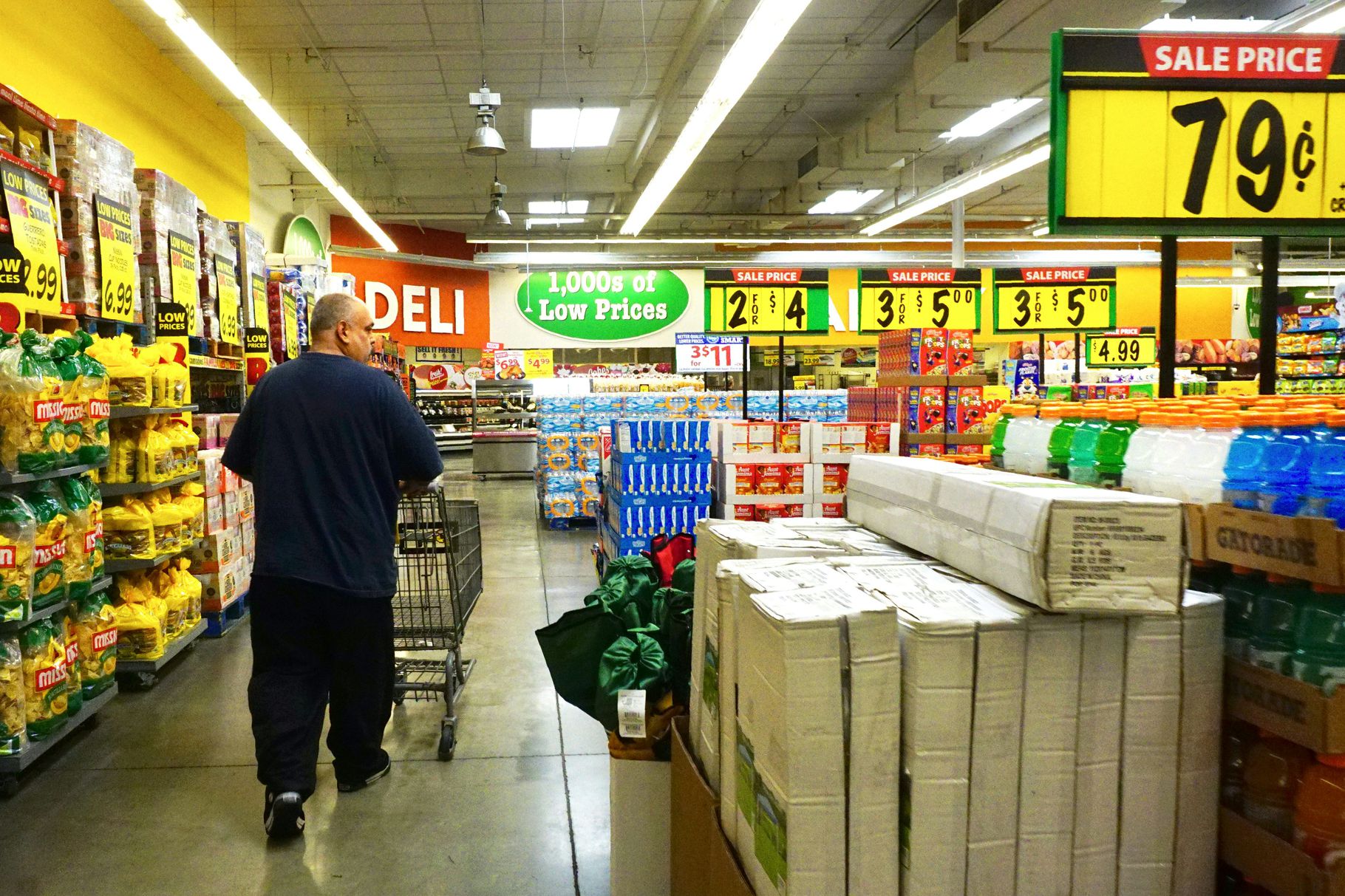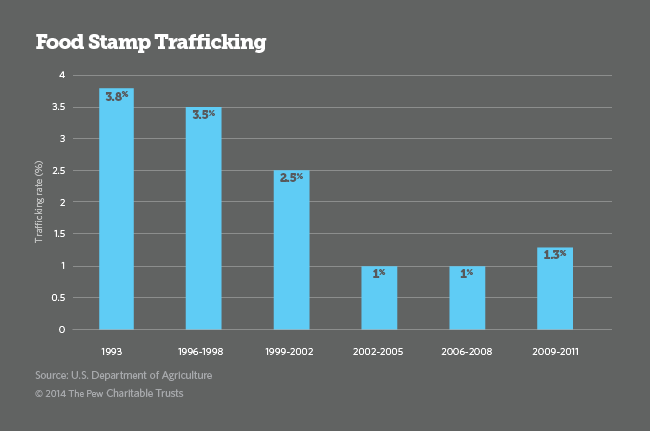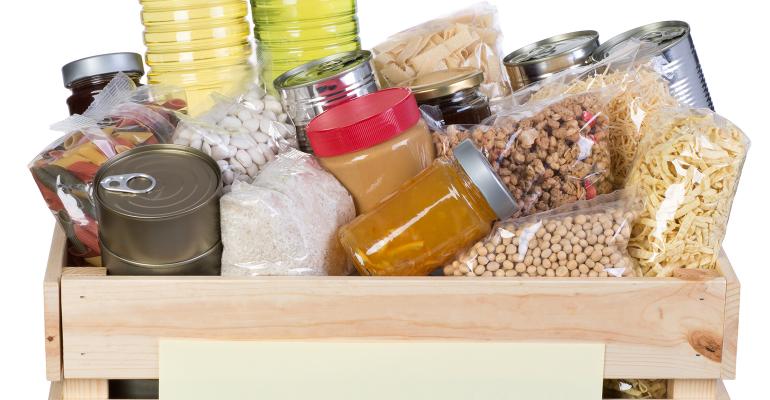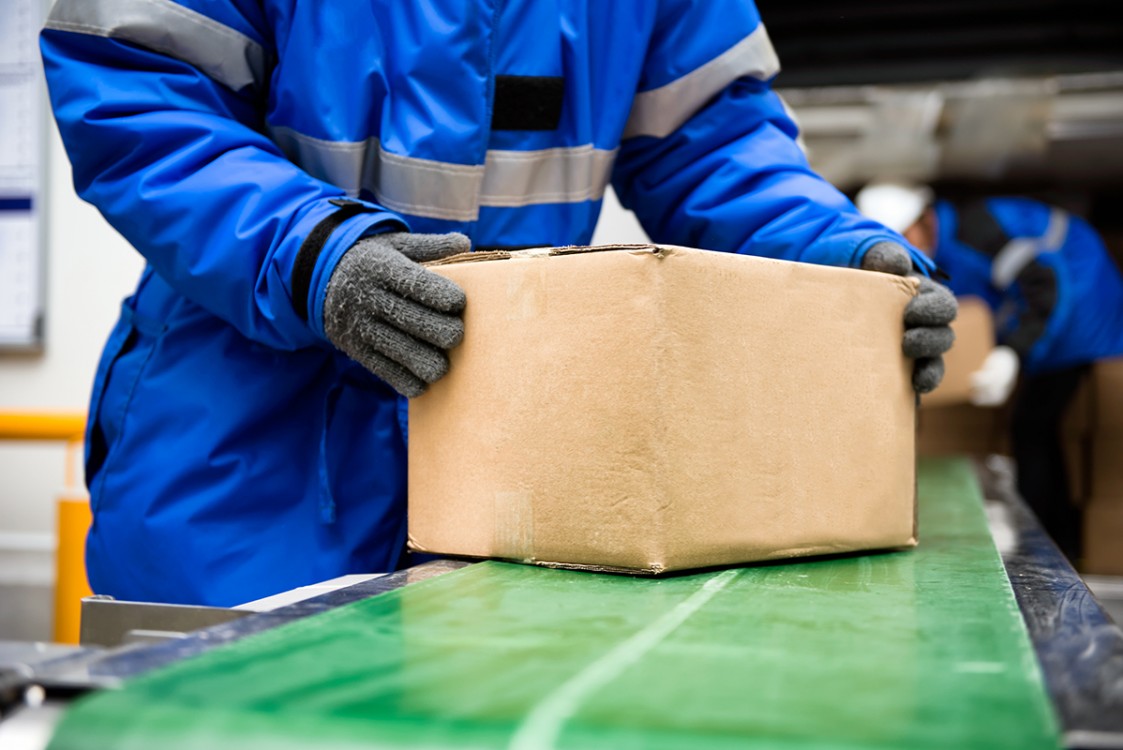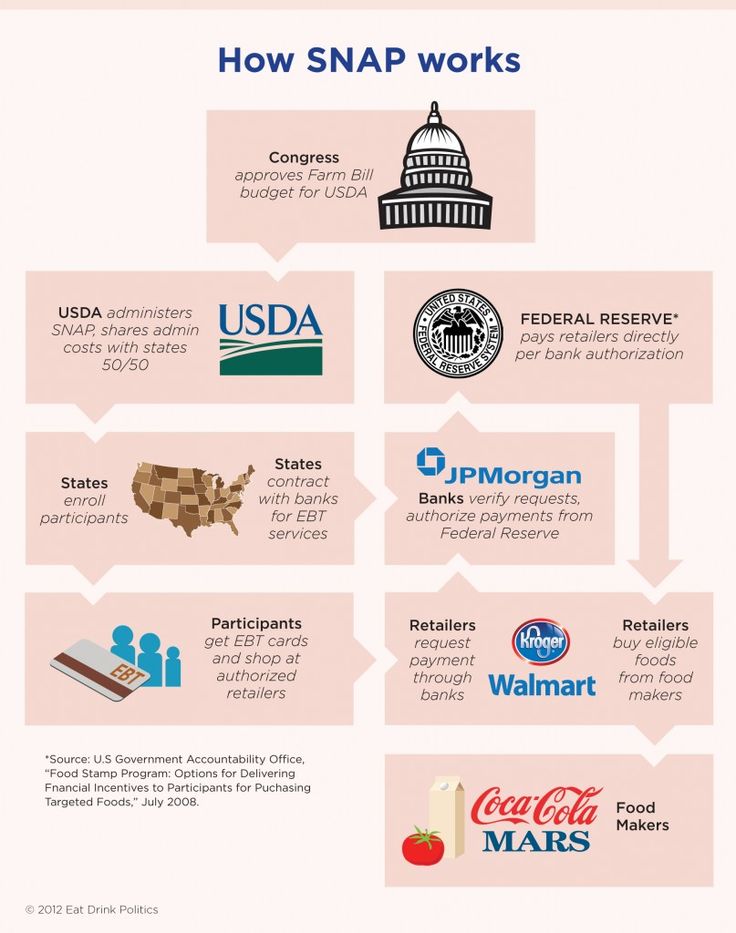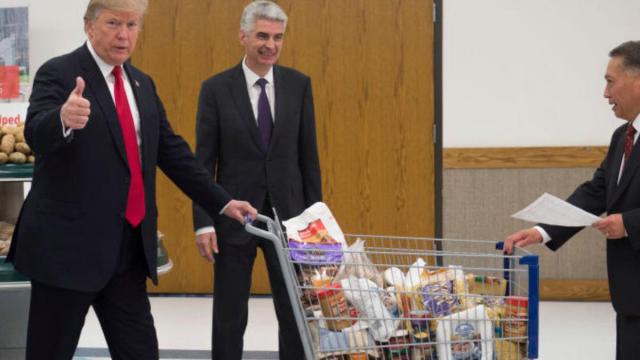
The Trump administration has proposed a radical overhaul to the food stamp program that would replace some people’s benefits with a “Harvest box” of products like shelf-stable milk, pasta, peanut butter, meat, and canned fruits and vegetables.
The changes are part of a dramatic proposed cut to funding for food stamps, or SNAP, adding up to more than $200 billion dollars over 10 years. Switching to “Harvest boxes,” according to the budget, would contribute $130 million of that savings.
SNAP serves about 42 million Americans, which includes low-income working families, and seniors and disabled people on fixed incomes. Currently, people who receive SNAP have their monthly benefit deposited to an EBT card — basically a special debit card — that lets them purchase unprepared food at authorized grocery stores or local businesses.
Under Trump’s proposal, rather than getting all of their benefits to spend on groceries, SNAP recipients who receive more than $90 a month in benefits would also get a package of food that includes “shelf-stable” milk, juice, cereals, pasta, peanut butter, canned meat, and canned fruits and vegetables, all “100 percent American-grown and produced.” They’d pay for those boxes with their benefits and get the remaining value on the EBT card, the way the program works now.
The change would affect about 16.4 million households — about 81 percent — of those receiving SNAP benefits, according to the USDA.
The Harvest box proposal is scant on implementation details: How boxes would be distributed, for example, is left up to the states. One expert described the idea as “puzzling,” solving no actual problems with the program but creating plenty of new ones.
The idea of getting a box of preassembled food has brought on comparisons to buzzy startups like Blue Apron that send subscribers, who can pay more than $200 per month, a preassembled meal kit of fresh ingredients, unusual condiments, and recipes.
The only thing the Trump proposal has in common with meal kit delivery services is the box. Its real effect would be giving people in need less choice about what they feed themselves and their families.
What is SNAP?
About 42 million Americans — including about 20 million children — receive benefits through the Supplemental Nutrition Assistance Program, or SNAP, formerly known as food stamps. Eligibility is determined based on income, generally at or below 130 percent of poverty line. A typical family of four can’t make more than $2,665 per month before taxes, a little less than $32,000 per year, to be eligible. (Full disclosure: I previously worked as a SNAP case manager in New York City.)
Right now, SNAP gives recipients broad choices about the food they buy, as long as it’s unprepared. They can buy healthy food or junk food, but they can’t buy prepared roast chickens or deli sandwiches. (They can buy seeds for planting, if available.) People buy food with EBT cards, which function as debit cards for eligible purchases. Items such as alcohol or cigarettes aren’t allowed, nor are any household items like paper towels or shampoo. People also can’t get SNAP benefits paid out in cash.
The average benefit is about $126 per person per month, or about $254 per household per month, according to the Center on Budget and Policy Priorities. That comes out to about $1.40 per meal — whether you live in New York or North Dakota.
The SNAP program helps lift millions of households out of poverty each year. It usually responds nimbly during times of economic hardship, such as during the Great Recession, or even natural disasters, and functions as economic stimulus. Ellen Vollinger, the SNAP director at the Food Research and Action Center, called SNAP an “economic multiplier.” For every $1 spent in SNAP benefits, it generates approximately $1.79 for the economy.
But as the Trump administration sees it, the program would improve the food stamps program by delivering recipients healthier foods, saving taxpayers money, and cutting down on EBT fraud.
SNAP has tried to promote better nutrition among its recipients — something policy makers have been grappling with, from debates over soda bans to expanding SNAP use at farmer’s markets. But food stamps are already a pretty efficient use of taxpayer money, and EBT fraud is relatively low.
Fraud in SNAP is Real — But at a Rate of About 1.5%
Fraud in SNAP does exist — usually when people trade SNAP benefits for cash or other banned goods, known as food stamp trafficking.
But it’s a tiny share of the program overall. The most recent USDA statistics, released in 2013, put at food stamp trafficking at about $858 million dollars. It amounts to about one cent for every dollar (compared to about four cents on the dollar in the 1990s). A 2017 USDA audit found that, in the past 16 years, trafficking rates fell to about 1.5%.
In fact, the move to EBT from physical food stamps is credited with reducing food stamps trafficking, because EBT leaves an electronic footprint to track both retailers and purchasers. EBT is not perfect — but the Harvest box doesn’t exactly seem fraud-proof. Recipients could sell a Harvest box for cash or claim a lost delivery and collect duplicates.
“It doesn’t seem like introducing more steps and more complexity and more intermediaries goes toward reducing fraud,” noted Stacy Dean, of the Center for Budget and Policy Priorities.
“Harvest boxes” are Supposed to be Healthier. But They Also Reduce Choice.
Previous research on SNAP has shown that people who do use the program have a slightly more unhealthy diet than those households who are eligible but don’t rely on the program. But the federal government has largely avoided banning certain foods or setting guidelines — and it’s not clear the Harvest box will adequately address these shortfalls.
USDA Secretary Sonny Perdue promised in a fact sheet that the program would provide “nutritious food to people who need assistance feeding themselves and their families,” and “all of it … home grown by American farmers and producers.”
This makes it seem as if the Harvest box is some farm-to-table treat, but it will mostly include items like “shelf-stable milk,” cereals, juices, and proteins.
The closest analogy that the federal government runs now is a program that distributes food boxes instead of SNAP benefits on American Indian reservations. Available foods include canned beans, corn, and spinach; dried eggs; dried and canned fruit; peanut butter; and canned and frozen meat. It’s a far cry from a meal kit box with fresh grass-fed beef, kale, and a tiny container of Sriracha. (And also serves far fewer people — about 90,000.)
Whether these Harvest boxes are healthy depends on what type of juice and grains make it inside, said Sara Abiola, an assistant professor of health policy and management at Columbia University. It matters, for example, whether the fruit is canned in water or syrup.
But more broadly, Abiola emphasized, while SNAP recipients might not always make the healthiest food choices, their decisions are rational in context — they tend to select relatively low-cost items that stretch a monthly budget, are filling, and easy to cook.
People who struggle to buy food might also live in substandard housing, or share living spaces with multiple people. “What happens if your kitchen is not functional?” Abiola said. It’s “idealistic to think that folks are going to be able to cook a ‘healthy’ meal,” she said, of the food boxes.
Harvest Boxes Would Need a Whole New Infrastructure
Harvest boxes would also seem to make the existing food stamp infrastructure a lot more complicated, undoing decades of changes that have streamlined the program.
The Trump plan harkens to the origins of the federal food stamp program during the Depression, said Elaine Waxman, a senior fellow at the Urban Institute. In that era, people in need received a mix of stamps that would cover normal purchases and special stamps to buy foods that the government considered “surplus.”
The “surplus” foods weren’t selected with the needs of hungry families in mind. Instead, they were agricultural products that were being overproduced, and farmers needed to offload some of them to drive up prices.
The surplus food stamps were eliminated when the food stamp program started again in the 1960s. Electronic cards began replacing stamps around the 1990s. Waxman said it isn’t clear why the federal government would want to return to that system, particularly when the electronic system is much less complicated.
SNAP relies on the food distribution networks most Americans rely on, getting food to retailers where customers buy it. “It piggybacks off the marketplace,” said Dean. The government doesn’t have to spend money on things such as transporting food because the private sector has it covered.
The government does have food delivery services, like those that serve American Indian reservations or elderly households , but not at the scale of millions of food stamp households. It’s also worth considering the impact on local or rural businesses who might lose business if their customers have less money to spend on food at their stores.
And there are plenty of unanswered questions about how this would work: Would boxes be delivered door-to-door? Would people have to be home to receive Harvest boxes — a likely challenge for shift workers? Or would people have to visit a distribution center? What happens to elderly or disabled individuals? What about transportation costs, or accessibility, particularly in rural areas?
Harvest boxes would also be less reliable, because delivery can easily be interrupted while transferring benefits to a debit card rarely is. This is particularly relevant during events such as natural disasters, which Vollinger says SNAP has tackled effectively because of its ability to electronically distribute emergency benefits through EBT.
Congress Probably Won’t Love Harvest Boxes — but the Threat of SNAP Cuts are Very Real
Harvest boxes could also end up being much more visible than ordinary SNAP benefits. Imagine a monthly delivery, stamped with a USDA label, sitting on a doorstep for all the neighbors to see — or having to go down to a local pantry or non-profit to pick up a food box every month.
EBT cards, by contrast, are more discreet. People go to the store and swipe a card; they don’t have to hand the cashier physical coupons. And Abiola said research has shown stigma does prevent people from accessing benefits because of embarrassment or shame.
“It’s just undoing a lot of broader work,” Abiola said, of trying to get people “being comfortable with using that assistance.”
But to some Republicans in Congress, the idea of people being “comfortable” with government assistance is objectionable. In 2012, Rep. Paul Ryan (R-WI) warned about turning the social safety net into a “hammock that lulls able-bodied people to lives of dependency and complacency.”
Six years later, Ryan is the House speaker, and the Harvest boxes are part of a broader budget that hacks away at the social safety net.
The Harvest box will probably face huge hurdles even in a Republican-controlled Congress because it’s such a dramatic change to SNAP. But it’s not impossible — and the budget still calls for another $85 billion in reductions.
The cash comes from a one-two punch of decreasing benefit amounts, and tightening eligibility requirements. The Center on Budget and Policy Priorities estimates about four million people could entirely lose SNAP benefits entirely. Some of the biggest losers are working families with kids, the elderly, and the disabled.
“A reduction in funding of that size means lost meals for people in need,” said Triada Stampas, vice president for research and public affairs at Food Bank for New York City. “It’s on a similar scale to what was proposed in the White House budget last year.” She added that when SNAP benefits get cut, it puts more strain on food banks and pantries — which then struggle to meet the rising need.
“It’s an enormous cut in benefits,” Vollinger said of the Trump budget proposal for SNAP. “That’s really the biggest takeaway.”
3 WAYS TO SHOW YOUR SUPPORT
- Log in to post comments

